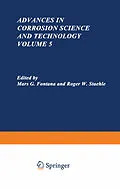This series was organized to provide a forum for review papers in the area of corrosion. The aim of these reviews is to bring certain areas of corrosion science and technology into a sharp focus. The volumes of this series are published approximately on a yearly basis and each contains three to five reviews. The articles in each volume are selected in such a way as to be of interest both to the corrosion scientists and the corrosion technologists. There is, in fact, a particular aim in juxtaposing these interests because of the importance of mutual interaction and interdisciplinarity so important in corrosion studies. It is hoped that the corrosion scientists in this way may stay abreast of the activities in corrosion technology and vice versa. In this series the term "corrosion" is used in its very broadest sense. It includes, therefore, not only the degradation of metals in aqueous en vironment but also what is commonly referred to as "high-temperature oxidation. " Further, the plan is to be even more general than these topics; the series will include all solids and all environments. Today, engineering solids include not only metals but glasses, ionic solids, polymeric solids, and composites of these. Environments of interest must be extended to liquid metals, a wide variety of gases, nonaqueous electrolytes, and other non aqueous liquids.
Inhalt
1 Surface Chemistry and Corrosion of Glass.- The Nature of Glass.- Structure.- Glass Composition.- Chemical Attack on Glass: Tests for Durability.- Powder Tests.- Weight Loss Tests.- Solubility of Silica.- Glass Structure and Ion Selectivity.- Chemical Attack on Glass.- General Considerations.- Water and Steam.- Acid Solutions.- Alkaline Solutions.- Chelating Agents.- Sulfur Dioxide and Sulfur Trioxide.- Ion Exchange in Molten Salts.- Phase Separation.- Surface Chemistry.- Miscellanea.- Weathering of Glass Surfaces.- Corrosion Resistance of Ceramics.- High-Temperature Attack on Glasses and Glass Ceramics.- Utilization of Corrosion Effects.- Summary.- References.- 2 Halogen Corrosion of Metals.- Pertinent Properties of Binary Metal Halides.- Thermodynamic Properties.- Melting Temperatures.- Diffusion Properties.- Vapor Pressures.- Experimental Methods Used to Study Metal-Halogen Reactions.- Manometric Method.- Gravimetric Method.- Photometric Method.- Electrical Resistance Method.- Quartz Crystal Microbalance.- Reaction Morphologies, Mechanisms, and Kinetics.- Reaction of Pure Metals.- Reaction of Alloys.- Laboratory Studies of Halogen Attack on Metals and Alloys.- Nickel and Nickel Alloys.- Copper and Copper Alloys.- Iron and Iron Alloys.- Aluminum and Aluminum Alloys.- Other Metals.- Conclusions.- References.- 3 Oxidation of Zirconium and Its Alloys.- Historical Development.- Influence of the Nuclear Reactor Industry on Development.- Comparison of General Features of Gaseous Oxidation and Aqueous Corrosion.- Oxidation in Dry Gases.- Oxygen and Air.- Carbon Dioxide.- Molten Sodium.- Fused Salts.- Oxidation in High-Temperature Aqueous Environments.- Historical Background.- Corrosion in Water and Steam.- Corrosion in Organic Coolants.- Oxidation Mechanisms.- Zircaloy-Type Alloys.- Zr-Nb Alloys.- Other Alloys.- Hydrogen Absorption.- Hydrogen Absorption from Gaseous Hydrogen.- Hydrogen Absorption via the Decomposition of H2O.- References.
